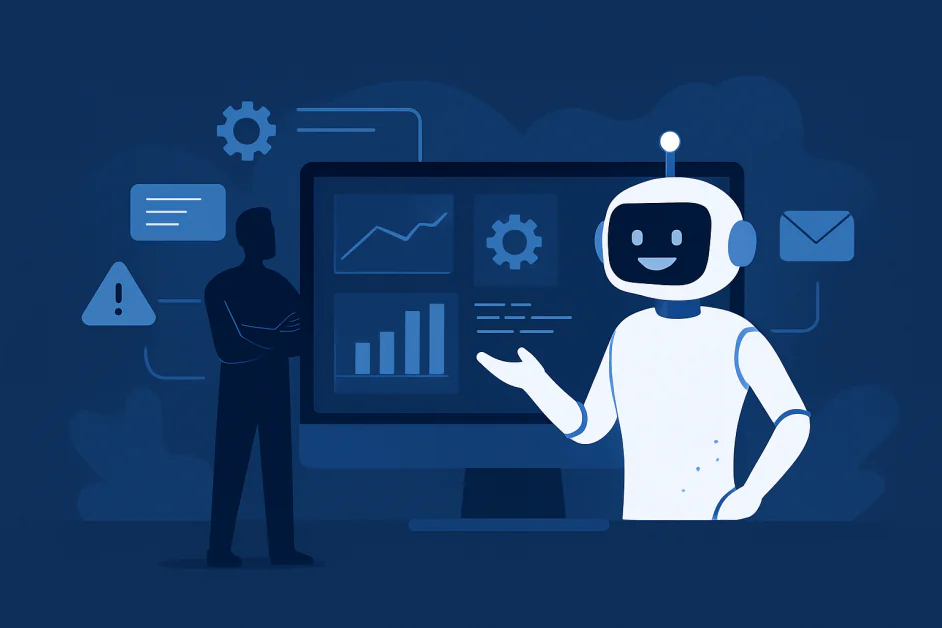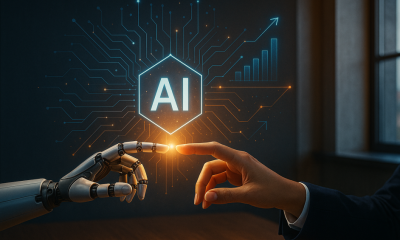Artificial Intelligence
Agentic AI and the Future of Observability: Smarter Monitoring for Complex Systems

Modern software systems are becoming more complex. They often operate across different cloud platforms, involve multiple teams, and rely on numerous tools simultaneously. To manage such systems properly, companies rely on observability.
Observability refers to understanding what is happening inside a system by examining the results it produces. These results include logs, metrics, and traces. By analyzing this data, engineers can find out where things are going wrong. This helps them fix issues quickly and maintain system stability.
But traditional observability methods are no longer enough. The data coming from modern systems is too much. It is complex to handle and even more challenging to understand in the moment. Older tools can display the data, but they cannot interpret it or take action based on it.
This is where agentic AI makes a big difference. It does not just display the data. It works like an intelligent assistant. It understands the system’s behavior. It finds problems and suggests solutions. In many cases, it can even fix the issue on its own. If human help is needed, it alerts the right person immediately.
By doing this, agentic AI speeds up the process of identifying and solving problems. It reduces the chance of human error. It also improves system performance and reliability. Most importantly, it can handle tasks across different tools without manual effort.
With this level of automation, observability becomes much more effective. Businesses can keep their systems running smoothly. They save time, reduce costs, and improve returns on their technology investments. Agentic AI is transforming observability, making it faster, smarter, and more useful for complex modern systems.
What Is Agentic AI and Why It Matters in Observability
Agentic AI refers to advanced, autonomous systems designed for goal-driven decision-making and action. Unlike Large Language Models (LLMs) that generate responses to human queries or rule-based automations that follow scripts, agentic AI can act autonomously, adapt and optimize based on feedback, retain context and memory, and reason through tasks in dynamic environments. While LLMs are reactive and rule-based, agentic AI exhibits flexible, self-directed behavior.
One of the most promising areas for applying agentic AI is observability. Modern digital systems are large and complicated. They run across different machines, networks, and cloud platforms. These systems generate vast amounts of data, consisting of logs, metrics, and traces, that engineers must monitor to ensure smooth performance.
But traditional observability tools cannot fully meet the needs of modern systems. These tools usually depend on dashboards, alerts, and manual checks. Engineers must watch for signs of trouble and take action when something goes wrong. This method works when systems are small and simple. However, today’s systems are large, distributed, and constantly changing.
As complexity increases, it becomes harder for teams to track everything. They receive too many alerts, many of which are not serious. This creates alert fatigue. Significant problems may be missed. Troubleshooting also becomes slower and more difficult. Valuable time is spent searching through logs, comparing metrics, and trying to find the root cause.
This is where agentic AI brings real value. Instead of waiting for humans to act, it becomes an active part of the observability process. It continuously monitors systems to understand what normal behavior looks like and quickly identifies any unusual activity. If a service slows down, agentic AI can check logs, analyze patterns, and trace the root cause. In some cases, it can even suggest a fix or take action automatically.
Over time, it learns from past incidents. If a solution worked before, it remembers and reuses it. This learning ability helps reduce the time needed to detect and resolve problems. It leads to fewer outages and a better user experience.
In simple terms, agentic AI transforms observability from a passive process into an intelligent, proactive one. It reduces pressure on human teams, improves system reliability, and supports smarter, faster decisions when systems behave unpredictably.
Integrating Agentic AI Across Multi-Tool Environments
Today’s observability systems often rely on many different tools. Platforms like New Relic, Datadog, and Prometheus each focus on specific areas. But they usually work in isolation. They do not share data or context. This creates problems such as repeated alerts, slow responses, and gaps in visibility.
Agentic AI addresses this problem by serving as a central layer between various tools. It consolidates data from multiple sources to provide a comprehensive view of the system. It connects related events that seem separate. It also helps coordinate actions across tools and teams, such as sending alerts or applying fixes when needed.
This approach improves automation. Agentic AI can detect problems by looking at combined signals. It does not need strict rules. It finds patterns and points to the root cause. It can also take action, such as restarting a service or applying a fix. In urgent cases, it can automatically alert the right team.
By breaking these silos, agentic AI makes observability more transparent and more efficient. It speeds up the process of identifying and resolving issues. This results in improved system performance and fewer disruptions.
Improving Observability with Intelligent Agentic Systems
In highly distributed and dynamic systems, understanding what is happening across services in real time is critical. Traditional observability tools depend on fixed alerts, static dashboards, and manual inspection. These tools often produce excessive noise and lack context, making it difficult to identify early signs of trouble. As systems scale, this manual approach becomes increasingly ineffective.
Agentic AI offers a more context-aware and adaptive approach to observability. Instead of relying on predefined rules, it learns typical system behavior from past and live data. This enables it to detect patterns that indicate instability, such as gradual performance degradation, abnormal resource utilization, or sudden traffic fluctuations. Because it adapts over time, agentic AI maintains accuracy even as systems evolve.
Beyond detection, it also provides actionable insights. It can prioritize alerts, highlight root causes, and recommend next steps. In many cases, it can apply fixes autonomously or suggest them to engineers with supporting evidence. This not only accelerates incident response but also helps teams make more informed decisions.
Agentic AI also enhances communication. It can tailor alerts to specific roles and responsibilities, ensuring that the right people receive the correct information. Each alert includes context about potential impact and urgency, reducing confusion and delays.
This shift improves both technical performance and human experience. Irrelevant alerts or unclear diagnostics do not burden engineers. They can focus on higher-level analysis and system improvements. The overall result is better service quality, faster recovery from anomalies, and more resilient operations.
In large-scale environments, these capabilities become essential. Agentic AI can process vast streams of observability data in real time across clouds, containers, and service meshes. It learns continuously and becomes more effective with use, without needing constant manual tuning.
It also supports accountability and compliance. By maintaining audit trails and providing explainable reasoning, it strengthens trust and facilitates easier reporting for governance purposes.
By embedding intelligence into observability, organizations move from passive monitoring to active understanding. Agentic AI transforms observability into a predictive and collaborative function, one that not only sees but helps shape system behavior toward stability and efficiency.
Scaling and Adapting Agentic AI in Enterprise Systems
Agentic AI scales effectively in large enterprise environments. It adapts to dynamic infrastructure such as Kubernetes clusters and service meshes by learning from live interactions. This allows it to track system behavior across hundreds of microservices without relying on manual rules or static thresholds.
In regulated settings, agentic AI strengthens security and compliance. It identifies policy violations as they occur, automates the logging of security anomalies, and keeps detailed records of decisions. These features support audit requirements and improve organizational transparency.
The system also offers customization. It aligns with organization-specific SLAs and KPIs. Through feedback loops, it refines its alert strategies and decision-making processes. This continuous improvement occurs without retraining from the beginning, reducing operational overhead.
These capabilities make agentic AI a reliable solution for maintaining performance, ensuring policy compliance, and adapting to evolving enterprise needs.
Emerging Trends and Practical Concerns for Agentic Observability
In the coming years, software observability is expected to transition to a new model known as cognitive observability. In this model, agentic AI systems will not only collect and report data but also understand and predict system behavior. These systems will go beyond dashboards and alerts. They will act as intelligent engines that can identify risks and opportunities before problems occur. By understanding the reasons behind system changes, teams can make better decisions with greater confidence.
Innovations in this area include AI agents inspired by human thought and learning processes. These systems can recall past events, learn from them, and make more informed choices over time. Some advanced models are being developed as DevOps co-pilots. These are fully autonomous agents that manage the entire observability cycle, from identifying issues to resolving them. They act as smart assistants that support developers and operations teams.
However, this progress brings some critical challenges. The systems rely on large amounts of data. If the data is of poor quality, the AI may produce wrong or unclear results. It is also essential for organizations to understand how AI reaches its decisions. Clear explanations are crucial for establishing trust, especially in critical systems. Although these agents can operate independently, human oversight remains necessary. Teams must ensure that the systems are used safely and ethically.
To benefit fully from cognitive observability, organizations must find a balance. They need to use automation while also keeping control. If done carefully, agentic AI can improve observability and make systems more reliable, adaptive, and intelligent.
The Bottom Line
Agentic AI is transforming observability from a reactive process into an intelligent, proactive capability. By learning from data, adapting to changing environments, and taking action when necessary, organizations can manage complex systems more effectively. It reduces alert fatigue, speeds up problem resolution, and improves system reliability.
Agentic AI is transitioning to a new stage known as cognitive observability. At this stage, systems can predict problems and understand what is happening before any issues arise. To derive real value from these systems, organizations must utilize them effectively. They should focus on using clean, accurate data. It is also essential to ensure that the AI operates in a transparent and explainable manner. Human oversight remains necessary to ensure that safety and ethical standards are maintained. When applied appropriately, agentic AI can enhance system performance, aid teams in making informed decisions, and foster more stable and reliable digital systems.












